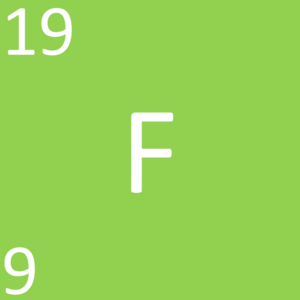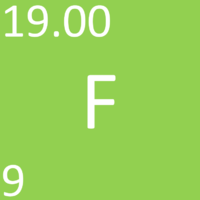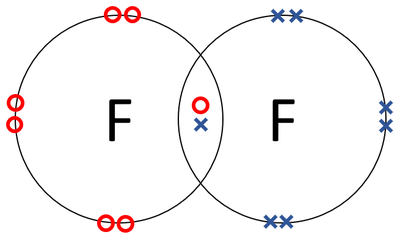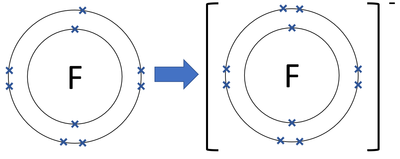Difference between revisions of "Fluorine"
(→About Fluorine) |
|||
| (27 intermediate revisions by 2 users not shown) | |||
| Line 3: | Line 3: | ||
[[Fluorine]] is a yellow [[gas]]. | [[Fluorine]] is a yellow [[gas]]. | ||
==Key Stage 3== | ==Key Stage 3== | ||
| + | [[File:FKS3.png|right|300px|thumb|The [[Chemical Symbol|chemical symbol]] for [[Fluorine]].]] | ||
| + | [[File:F-19_WK.PNG|right|200px|thumb|A 2 dimensional representation of a [[Fluorine]] [[atom]] with 9 [[proton]]s and 10 [[neutron]]s in the [[Atomic Nucleus|nucleus]] and 9 [[electron]]s orbiting the [[Atomic Nucleus|nucleus]].]] | ||
===Meaning=== | ===Meaning=== | ||
| − | |||
[[Fluorine]] is a [[Group 7]] [[element]], on the [[Periodic Table]], with an [[Atomic Number|atomic number]] of 9. | [[Fluorine]] is a [[Group 7]] [[element]], on the [[Periodic Table]], with an [[Atomic Number|atomic number]] of 9. | ||
===About Fluorine=== | ===About Fluorine=== | ||
| + | ====Molecular Structure==== | ||
: [[Fluorine]] has the [[Chemical Formula|chemical formula]] [[Fluorine| F<sub>2</sub>]]. | : [[Fluorine]] has the [[Chemical Formula|chemical formula]] [[Fluorine| F<sub>2</sub>]]. | ||
| + | |||
| + | ====Atomic Structure==== | ||
: [[Fluorine]] as 9 [[proton]]s and 10 [[neutron]]s in its [[Atomic Nucleus|nucleus]] giving it an [[Atomic Number]] of 9 and an [[Relative Atomic Mass|atomic mass]] of 19. | : [[Fluorine]] as 9 [[proton]]s and 10 [[neutron]]s in its [[Atomic Nucleus|nucleus]] giving it an [[Atomic Number]] of 9 and an [[Relative Atomic Mass|atomic mass]] of 19. | ||
| + | : An [[atom]] of [[Fluorine]] is missing one [[electron]] from having a full [[Outer Shell|outer shell]]. | ||
| + | |||
| + | ====Properties==== | ||
| + | : [[Fluorine]] is a [[non-metal]] [[element]]. | ||
: [[Fluorine]] is the most [[Reactivity|reactive]] [[Halogen]]. | : [[Fluorine]] is the most [[Reactivity|reactive]] [[Halogen]]. | ||
: [[Fluorine]] [[Chemical Reaction|reacts]] strongly with [[Hydrogen]] to produce [[Hydrogen Fluoride]] which [[dissolve]]s in [[water]] to produce [[Hydrofluoric Acid]]. | : [[Fluorine]] [[Chemical Reaction|reacts]] strongly with [[Hydrogen]] to produce [[Hydrogen Fluoride]] which [[dissolve]]s in [[water]] to produce [[Hydrofluoric Acid]]. | ||
| Line 14: | Line 22: | ||
: [[Fluorine]] kills [[bacteria]]. | : [[Fluorine]] kills [[bacteria]]. | ||
: [[Fluorine]] is a yellow coloured [[gas]] at [[STP|room temperature]]. | : [[Fluorine]] is a yellow coloured [[gas]] at [[STP|room temperature]]. | ||
| − | + | ||
| − | |||
==Key Stage 4== | ==Key Stage 4== | ||
| + | [[File:FKS4.PNG|right|200px|thumb|The [[Chemical Symbol|chemical symbol]] for [[Fluorine]].]] | ||
| + | [[File:F-19_WK.PNG|right|200px|thumb|A 2 dimensional representation of the [[Bohr Model]] of a [[Fluorine]]-19 [[isotope]] with 9 [[proton]]s and 10 [[neutron]]s in the [[Atomic Nucleus|nucleus]] and 2 [[electron]]s in the first [[Electron Orbital|shell]] and 7 in the [[Outer Shell|outer shell]].]] | ||
===Meaning=== | ===Meaning=== | ||
| − | [[Fluorine]] is a [[Group | + | [[Fluorine]] is a [[Group 7]] [[element]], on the [[Periodic Table]], with 9 [[proton]]s in the [[Atomic Nucleus|nucleus]]. |
===About Fluorine=== | ===About Fluorine=== | ||
| + | ====Molecular Structure==== | ||
: [[Fluorine]] has the [[Chemical Formula|chemical formula]] [[Fluorine|F<sub>2</sub>]]. | : [[Fluorine]] has the [[Chemical Formula|chemical formula]] [[Fluorine|F<sub>2</sub>]]. | ||
| + | : [[Fluorine]] [[atom]]s join together in a [[Covalent Bond|covalent bond]]. | ||
| + | {| class="wikitable" | ||
| + | |- | ||
| + | |[[File:FluorineDotandCrossDiagram.png|center|400px]] | ||
| + | |- | ||
| + | | style="height:20px; width:200px; text-align:center;" |A [[Dot and Cross Diagram|dot and cross diagram]] of a [[Fluorine]] [[molecule]]. | ||
| + | |} | ||
| + | |||
| + | ====Atomic Structure==== | ||
: The most [[Stable Isotope|stable isotope]] of [[Fluorine]] has 10 [[neutron]]s in its [[Atomic Nucleus|nucleus]] giving it an [[Relative Atomic Mass|atomic mass]] of 19. | : The most [[Stable Isotope|stable isotope]] of [[Fluorine]] has 10 [[neutron]]s in its [[Atomic Nucleus|nucleus]] giving it an [[Relative Atomic Mass|atomic mass]] of 19. | ||
| + | : An [[atom]] of [[Fluorine]] is missing one [[electron]] from having a full [[Outer Shell|outer shell]]. | ||
| + | : '''Fluoride''' [[ion]]s gain 1 [[electron]] to get a full [[Outer Shell|outer shell]] and become [[Negative Charge|negatively charged]]. | ||
| + | {| class="wikitable" | ||
| + | |- | ||
| + | |[[File:FluorineIonFormation.png|center|400px]] | ||
| + | |- | ||
| + | | style="height:20px; width:200px; text-align:center;" |A [[diagram]] showing the formation of a '''Fluoride''' [[ion]]. | ||
| + | |} | ||
| + | |||
| + | ====Properties==== | ||
| + | : [[Fluorine]] is a [[non-metal]] [[element]]. | ||
: [[Fluorine]] is the most [[Reactivity|reactive]] [[Halogen]]. | : [[Fluorine]] is the most [[Reactivity|reactive]] [[Halogen]]. | ||
: [[Fluorine]] [[Chemical Reaction|reacts]] strongly with [[Hydrogen]] to produce [[Hydrogen Fluoride]] which [[dissolve]]s in [[water]] to produce [[Hydrofluoric Acid]]. | : [[Fluorine]] [[Chemical Reaction|reacts]] strongly with [[Hydrogen]] to produce [[Hydrogen Fluoride]] which [[dissolve]]s in [[water]] to produce [[Hydrofluoric Acid]]. | ||
| Line 27: | Line 57: | ||
: [[Fluorine]] kills [[bacteria]]. | : [[Fluorine]] kills [[bacteria]]. | ||
: [[Fluorine]] is a yellow coloured [[gas]] at [[STP|standard temperature and pressure]]. | : [[Fluorine]] is a yellow coloured [[gas]] at [[STP|standard temperature and pressure]]. | ||
| − | |||
| − | |||
| − | ===Testing For Fluorine=== | + | ====Testing For Fluorine==== |
#Collect the [[gas]] in a [[Test Tube|test tube]]. | #Collect the [[gas]] in a [[Test Tube|test tube]]. | ||
#Place a piece of [[Litmus Paper|litmus paper]] over the mouth of the [[Test Tube|test tube]]. | #Place a piece of [[Litmus Paper|litmus paper]] over the mouth of the [[Test Tube|test tube]]. | ||
#If the [[Litmus Paper|litmus paper]] is [[bleach]]ed white then the [[gas]] is [[Fluorine]] or [[Chlorine]]. | #If the [[Litmus Paper|litmus paper]] is [[bleach]]ed white then the [[gas]] is [[Fluorine]] or [[Chlorine]]. | ||
| + | |||
| + | ===References=== | ||
| + | ====AQA==== | ||
| + | |||
| + | :[https://www.amazon.co.uk/gp/product/1782945962/ref=as_li_tl?ie=UTF8&camp=1634&creative=6738&creativeASIN=1782945962&linkCode=as2&tag=nrjc-21&linkId=476bb5c8d1dfb5c08ac81b6d4d1c98d8 ''Fluorine, page 61, GCSE Chemistry, CGP, AQA ''] | ||
| + | :[https://www.amazon.co.uk/gp/product/178294639X/ref=as_li_tl?ie=UTF8&camp=1634&creative=6738&creativeASIN=178294639X&linkCode=as2&tag=nrjc-21&linkId=51599bb45a2bfaf7c1b6a978b2ca2616 ''Fluorine, page 61, GCSE Combined Science Trilogy; Chemistry, CGP, AQA ''] | ||
| + | :[https://www.amazon.co.uk/gp/product/0008158762/ref=as_li_tl?ie=UTF8&camp=1634&creative=6738&creativeASIN=0008158762&linkCode=as2&tag=nrjc-21&linkId=a0fffa35b3ea49a63404f6704e0df7cc ''Fluorine, pages 26, 44-5, 61, GCSE Chemistry; Student Book, Collins, AQA ''] | ||
Latest revision as of 13:56, 19 February 2021
Contents
Key Stage 2
Meaning
Key Stage 3
Meaning
Fluorine is a Group 7 element, on the Periodic Table, with an atomic number of 9.
About Fluorine
Molecular Structure
- Fluorine has the chemical formula F2.
Atomic Structure
- Fluorine as 9 protons and 10 neutrons in its nucleus giving it an Atomic Number of 9 and an atomic mass of 19.
- An atom of Fluorine is missing one electron from having a full outer shell.
Properties
- Fluorine is a non-metal element.
- Fluorine is the most reactive Halogen.
- Fluorine reacts strongly with Hydrogen to produce Hydrogen Fluoride which dissolves in water to produce Hydrofluoric Acid.
- Fluorine is a strong bleaching agent.
- Fluorine kills bacteria.
- Fluorine is a yellow coloured gas at room temperature.
Key Stage 4
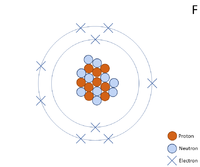
A 2 dimensional representation of the Bohr Model of a Fluorine-19 isotope with 9 protons and 10 neutrons in the nucleus and 2 electrons in the first shell and 7 in the outer shell.
Meaning
Fluorine is a Group 7 element, on the Periodic Table, with 9 protons in the nucleus.
About Fluorine
Molecular Structure
- Fluorine has the chemical formula F2.
- Fluorine atoms join together in a covalent bond.
| A dot and cross diagram of a Fluorine molecule. |
Atomic Structure
- The most stable isotope of Fluorine has 10 neutrons in its nucleus giving it an atomic mass of 19.
- An atom of Fluorine is missing one electron from having a full outer shell.
- Fluoride ions gain 1 electron to get a full outer shell and become negatively charged.
| A diagram showing the formation of a Fluoride ion. |
Properties
- Fluorine is a non-metal element.
- Fluorine is the most reactive Halogen.
- Fluorine reacts strongly with Hydrogen to produce Hydrogen Fluoride which dissolves in water to produce Hydrofluoric Acid.
- Fluorine is a strong bleaching agent.
- Fluorine kills bacteria.
- Fluorine is a yellow coloured gas at standard temperature and pressure.
Testing For Fluorine
- Collect the gas in a test tube.
- Place a piece of litmus paper over the mouth of the test tube.
- If the litmus paper is bleached white then the gas is Fluorine or Chlorine.
